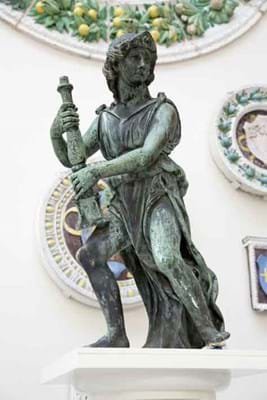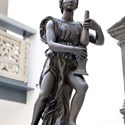The Victoria & Albert Museum's £5m purchase of all four of the Renaissance bronzes - one pair was stolen in the 1980s then purchased in good faith by a gallery in France - caps one of the great art world stories of recent times.
The angels, currently on display at the South Kensington museum prior to restoration, were conceived by the Florentine sculptor Benedetto da Rovezzano (1474-1552) as part of a magnificent funerary monument to Henry VIII's chancellor, Cardinal Wolsey.
Benedetto, a contemporary of Michelangelo and described by Giorgio Vasari as "…among our most excellent craftsmen", worked in England from 1519-43, with Wolsey his principal patron.
The angels, each measuring around a metre high, date to 1524-29 - the period in which Henry VIII was seeking to annul his marriage to Catherine of Aragon.
Henry appropriated the incomplete tomb, along with the rest of Wolsey's possessions, when his former chancellor, facing a charge of treason, died and was buried without ceremony somewhere in Leicester in 1530.
Benedetto's English Masterpiece
Benedetto, working with a team of founders and other craftsmen at Westminster, was commissioned to finish his English masterpiece for the King, but the project faltered, as did the expressed desire of Henry's three children to see the memorial completed posthumously.
Elizabeth I had the components moved to Windsor in 1565, where they remained until around 1645-6 when they were sold to raise funds during the Civil War. Only the black marble sarcophagus, now housing the mortal remains of Nelson in the crypt of St Paul's, was known to have survived, although four large gilt-bronze candlesticks were later found installed at St Bavo's Cathedral in Ghent.
Discovery of Angels
The first suggestion of the existence of the angels emerged in the early 2000s. Italian scholar Francesco Caglioti chanced on a pair of bronzes owned or part-owned by the Parisian works of art dealer Guy Ladrière. The world authority on Benedetto, Caglioti compared the sculptures with those catalogued in an inventory of Wolsey's possessions in 1530, and the details matched exactly.
The V&A became aware of the discovery, but it was not until 2008, when a second pair of angels was tracked down at Harrowden Hall, a country house in Northamptonshire, that the case became more compelling.
It was a remarkable discovery and offered the unexpected opportunity to reunite four works of sculpture so intimately connected with the course of British history.
However, there was a problem.
It emerged that Harrowden Hall, owned since the 1970s by the Wellingborough Golf Club, had displayed all four sculptures from the tops of gateposts until as recently as 1988 when two were stolen.
At the time the local police had assumed that the thieves had targeted the weather-beaten sculptures for their scrap value.
It is thought that they might have been part of the garden décor since the 18th century when the property in its current guise was built and furnished by the Wentworth Woodhouse family.
The remaining pair had been taken down from their prominent display for safer keeping inside the hall.
It emerged that the stolen pair had resurfaced six years later at an unwitting Sotheby's when, unillustrated and catalogued simply as being 'in Italian Renaissance style', they sold for just £12,000. Guy Ladrière (now of Galerie Ratton-Ladrière), acquired them soon afterwards in good faith and oversaw their repatination with a coat of 'bronze' coloured wax.
Obstacles to V&A Sale
As soon as the club learned of the angels' provenance, they lent their pair to the V&A and were keen to monetise their asset. But any transaction would be far from straightforward.
The club were unable to sell their pair at auction because they formed part of the Grade I listing at Harrowden Hall.
Under English law the club also retained title to the stolen pair - but how would their claim stand up in France where Ladrière had acquired them in good faith and years had passed since the statute of limitations had expired?
Ultimately, a pragmatic compromise was reached, with the club ceding their claim to the stolen pair on the understanding that a syndicate created for the purpose would offer all four statues for sale on behalf of both the club and Ladrière. The resulting windfall should bring the club more than £2.5m to secure their future.
During the final weeks of the fundraising campaign, all four of the Wolsey Angels had been reunited for the first time since 1988 in the V&A's Medieval & Renaissance Galleries - a photoshoot hastily arranged with actor Jonathan Pryce, who donned the scarlet robes and cap he wore when playing the part of Wolsey in the BBC series based on Hilary Mantel's Wolf Hall.
The four sculptures were valued at £5m. The National Heritage Memorial Fund and the Art Fund pledged half, and the V&A launched a successful public appeal to raise the other £2.5m.
The pieces will now undergo conservation treatment and their differing surface appearances investigated and harmonised. The 1530 inventory refers to the angels as 'not yet gilded'. They will go back on display once the work has been complete.
Dr Paul Williamson, chief curator of sculpture at the V&A, said: "It is an astonishing discovery. Nobody imagined these things had survived. And if the two angels hadn't been stolen, they would still be on the gateposts and nobody would know what they were. So, in a way, ultimately [the golf club] will benefit from the theft."









